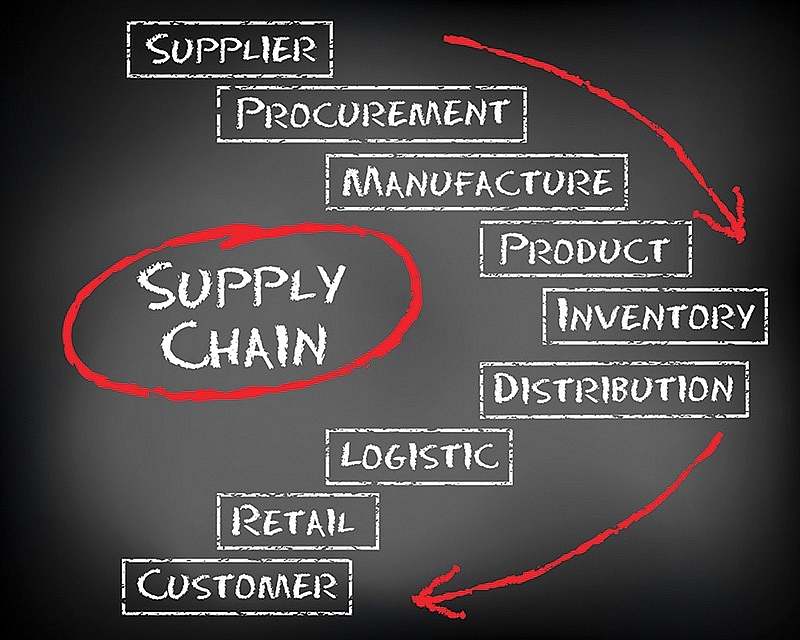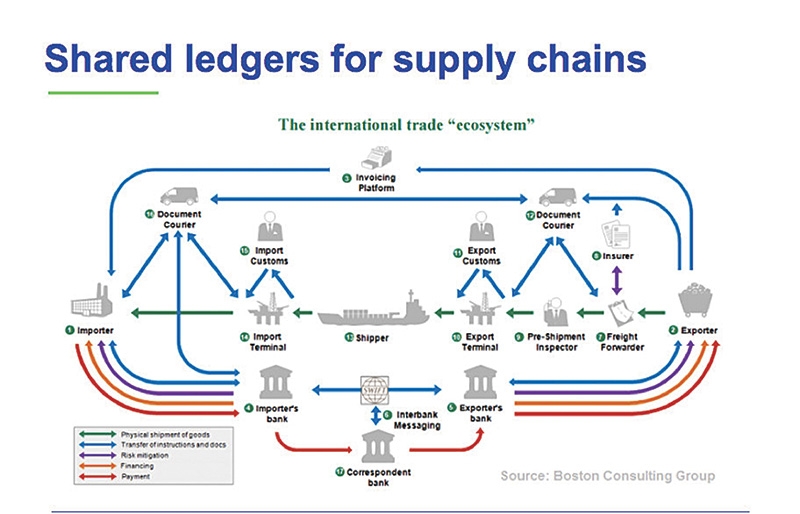Smoother and smarter supply chains
 |
| Blockchain solves issues that can hinder the efficiency of the supply chain |
Have you ever wondered what a shrimp-flavoured snack has gone through to reach the hands of consumers? From the initial stages of creating the ingredients – raising, planting, and catching shrimp – to combining materials together and processing into a flavoured snack, the next step will be the packaging of the product. After that, the snacks will be shipped to distribution agents, retailers, and eventually to consumers. All of these processes make up what is known as the supply chain.
 |
| Huynh Nhat Duat |
Ganeshan & Harrison from Penn State University in 1995 identified that the supply chain is a process that begins with raw materials until the product is made, or the service reaches the end-consumer. It is a network of distribution options and procurement of materials, transforming them through intermediaries to create and distributing items to consumers.
In businesses management, supply chain management directly affects the production and business activities of a company. Good supply chain management activities will help businesses achieve competitive advantages, offer a chance in the market, and expand the strategy and reach of businesses.
Supply chain management is closely linked to almost all operations of manufacturing enterprises, from planning and managing the process of sourcing, purchasing, and producing finished products; from raw materials, to co-ordinating with partners, suppliers, intermediate channels, service providers, and customers.
In general, supply chain management includes managing supply and demand throughout the system of businesses. Thanks to efficient supply chain management, world-class corporations such as Dell and Wal-Mart achieve 4-6 per cent higher profit than their competitors, a competitive advantage that is not small at all.
Well-performed supply chain management activities ensure the input and output of products. At the input, the amount of products by an enterprise is forecast to meet the needs of consumers, market demand, reduce the inventory of products and the level of risk of the business. At the output of the product, it provides enough for the market, bringing about revenue progress.
In addition, good supply chain management also means a good logistics performance, bringing products to businesses and customers quickly, ensuring freshness of products, minimising costs, and increasing profits.
Current supply chains
For Vietnamese enterprises with small- and medium-sized business models, it is very difficult to have a specialised department for the supply chain. The basic factor for successful competitive businesses today is either willingness to invest in a supply chain management department, or specialised units in charge of each stage such as finding, importing, and exporting goods, as well as shipping and money transfer. This is particularly important in the agricultural sector in Vietnam.
The reality of current agricultural products in the country is that both domestic and foreign consumers are concerned about the origin and quality of products. Therefore, it is necessary to quickly regain confidence for domestic consumers before the Vietnamese agricultural market share falls into the hands of imported products.
In addition, when comparing prices between two products, most tend to choose cheaper items, although the difference may not be much. This inadvertently creates a trend of unfair competition when some manufacturers want to lower prices but ignore necessary steps or choose poor-quality partners in many related stages.
As a result, the selection of cheap products has a negative impact on consumers. However, if comparing two products again and the more expensive item is a brand with stickers to ensure origin and quality, consumers will more likely choose that. Of course, the other labels must also be built on a reliable platform that can be continuously verified.
In addition to regaining domestic dominance, creating trust for Vietnamese agricultural products to travel further is also a matter of concern. For developed markets like the United States and Europe, the standard of products that can be imported here is very high. In particular, food probably tops this list by directly affecting consumers’ health.
If exports to these markets increases, the income of farmers will be greatly improved, contributing to the development of the country. However, this is not easy. Thus, there is now an urgency to develop supply chain management on the blockchain platform. With advantages such as transparency or immutability, this solution is the future in supply chain management.
 |
Blockchain for supply chain
LINA Network is one of the first corporations to apply blockchain to supply chain management. Blockchain was chosen by LINA as the foundation for the current supply chain because it solves the three core factors of immutability, transparency, and security.
The first factor is one of the most important properties of blockchain. Its information storage mechanism takes place in a one-way direction – information in the previous blocks will not be directly changed, but information that has been changed will be updated.
As for transparency in the payment application, we can access all transactions of the wallet owner whenever we know their public key. All transaction information will be stored on the blockchain and accessible to everyone. Information cannot be deleted – it may be changed but will leave a trace.
Regarding security, unlike an internet platform operated by just a single server, where all information could be stolen if the server is attacked, in blockchain, its mechanism of operation is to own multiple management servers at the same time. Therefore, it is difficult for hackers to attack hundreds of servers operating at the same time.
However, in order to apply blockchain into the supply chain, the first criterion is that businesses’ supply chains must be sufficiently accurate.
On the blockchain platform, each node will represent a stage in commodity production, such as raising, planting, packaging, and transporting. At each node, there will be administrators censoring information to put on the blockchain system, besides the admin of the whole network will be the censor of the final information to put into the main supply chain of the business. So at every stage, the manufacturing process is essentially a small supply chain.
The information will be moderated and updated by the manager, then updated to the system. The information will be transparent to each other and updated for the whole network. When information is censored and updated on the system, all amendments will be recorded so when an incident such as food poisoning occurs, the altered information will be detected and investigated.
When a user buys a product and wants to trace the product origin, the user must scan the QR code on the product. To scan a QR code, users will have to download the QR code scanning application provided by LINA. This LINA app released a demo in June at the Propak Thailand event.
However, because of the confidentiality of business information, users will be authorised to access certain stages to know the origin of the product. When an incident occurs, the authorised party will be allowed access to the entire system, including small supply chains, to investigate as needed.
Meanwhile, for the current platform, all information is obscured because the supply chain is only managed by one person, and all modifications can be obscured without being able to trace it back. Because of these advantages, the application of blockchain to the supply chain is increasingly urgent. At that time, businesses will improve their reputation before users, and thanks to transparency and immutability, farmers will be more careful when taking care of plants or animals.
The blockchain technology is increasingly developing and expanding. It is no longer encapsulated by applications that are just virtual, such as money, but have crept into the depths of every aspect of life, bringing benefits to businesses and users.
What the stars mean:
★ Poor ★ ★ Promising ★★★ Good ★★★★ Very good ★★★★★ Exceptional
Related Contents
Latest News
More News
- Tungsten surges to 12-year high as world enters a new 'black gold' race (December 18, 2025 | 17:27)
- Vietnam’s coffee exports set new record despite price pressures (December 18, 2025 | 17:13)
- Garment and textile sector seeks new growth after volatile year (December 18, 2025 | 17:01)
- VinSpeed and Siemens strengthen cooperation for high-speed rail development (December 18, 2025 | 16:53)
- High-tech adoption for TH true MILK (December 18, 2025 | 13:39)
- Takeda supports health resilience amid climate change challenges (December 18, 2025 | 12:39)
- Mondelez Kinh Do - a chapter of purpose-led leadership in Vietnam (December 18, 2025 | 09:44)
- VNPAY services receive the highest-level PCI DSS international security certificates for six consecutive years (December 17, 2025 | 23:47)
- PPL extends its reach into ASEAN (December 17, 2025 | 15:44)
- Over 600 BUV graduates meeting quality benchmarks across triple quality assurance levels (December 17, 2025 | 13:00)

 Tag:
Tag:






















 Mobile Version
Mobile Version